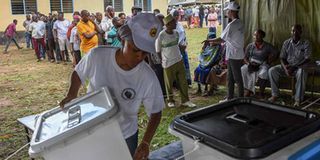The glaring data gap on women, youth and PWDs in 2024 polls

What you need to know:
- There is still no official election report providing an account of how the elections went
By Victoria Lihiru
As Tanzania turns its gaze toward the upcoming General Election, one important matter remains unresolved: the full picture of the November 2024 local government elections—which involved the election of chairpersons for 12,319 villages, 64,886 hamlets, and 4,264 streets, along with members of village councils and street committees—has yet to be publicly accounted for.
On November 28, 2024, the Minister of State in the President’s Office – Regional Administration and Local Government (PO-RALG), Mohamed Mchengerwa, issued a preliminary statement noting that out of 31 million registered voters, 16 million were women and 15 million were men. While this headline figure reflects gender parity in registration, it is where the data trail begins and ends.
Six months on, there is still no official election report providing an account of how the elections went and or detailing how various community groups participated in the elections. Beyond the number of women who vied for one-third reserved seats, no disaggregated data exists to show how women, youth, and persons with disabilities (PWDs) contested for chairperson or mixed-group member positions, who won, what voter turnout looked like, what challenges were encountered, or recommendations for future elections.
While the voter roll captured registrants’ age and gender, it entirely omitted disability status—a critical data point for inclusive electoral planning. This omission meant that PO-RALG lacked the necessary information to adequately accommodate voters with visual, mobility, or hearing impairments. Although electoral regulations permitted voters with disabilities to be assisted by others, this arrangement undermines the right to a secret ballot and contradicts the principle of independent voting.
The lack of foresight was also evident in the inaccessibility of polling stations, most of which were located in public schools and government offices lacking ramps, wheelchair-accessible booths, Braille ballots, and other assistive technologies. For voters with hearing impairments, the absence of sign language interpreters further deepened their exclusion. These barriers disproportionately affect women with disabilities, who face compounded discrimination and are effectively locked out of full political participation.
The data gap extends beyond the voter roll. Although nomination forms for candidates collected information on age, gender, location, and disability status, this data is yet to be been fully analyzed and populated into the report. Ballot papers and election result declaration forms also failed to capture comprehensive demographic information. While gender was sometimes recorded, age and disability status were excluded, making it impossible to build accurate profiles of those who contested or won seats. This inconsistency—combined with manual data entry, limited data storage, and the lack of digital infrastructure—has severely undermined efforts to assess how women, youth, and PWDs participated in the 2024 local government elections.
Apart from the number of women who came forward for quota seats—clearly identifiable as female—the number of candidates for chairperson and mixed-group seats was presented in aggregate, without disaggregation. PO-RALG’s preliminary report focused solely on party performance, noting that the ruling party, CCM, won 98–99 percent of positions across all levels. To date, the public still does not know: Who won? How many were women? How many were youth? Were any persons with disabilities elected—and in what roles?
In a democracy, data is not just numbers—it is power. Without it, women, who make up 51 percent of Tanzania’s population, youth, and or PWDs, who comprise 11 percent, remain invisible within systems that claim to serve them. Quality electoral data enables inclusive policy development, informs future electoral planning and funding decisions, and helps design effective capacity-building initiatives and legal reforms. Critically, it also supports Tanzania in meeting its obligations under subregional, regional, and international frameworks—including the Sustainable Development Goals (SDGs), whose deadline is fast approaching in 2030. When this data is missing, so too are the people behind the numbers.
At the grassroots level, women primarily access leadership through reserved seats. Each village council comprises 25 members, with eight seats reserved for women to meet the one-third quota. The rest includes one chairperson, five hamlet chairpersons, and eleven mixed-group members. Hamlet-level elections select a single chairperson per hamlet—with no reserved seats for women. At the street level, each committee has six members: one chairperson, three mixed-group members, and two women’s group members.
Although women can contest non-reserved positions, in reality, few do. In the 2019 local government elections, women accounted for just 2.1 percent of elected village chairpersons, 6.7 percent of elected hamlet chairpersons, and 12.6 percent of elected street chairpersons. This data set show that, while the one-third quota helped women secure approximately 30 percent of overall seats, their representation in elected leadership remained disproportionately low. Given that no gender-disaggregated data has been published for 2024, there is little reason to believe that significant progress has been made.
The newly enacted Independent National Electoral Commission (INEC) Act includes a mandate for supervising local government elections—a partial response to long-standing concerns about the neutrality of PO-RALG, even though INEC’s own independence remains under public scrutiny. However, this provision can only be enforced if Parliament passes supplementary legislation to define how INEC will take over responsibility for local government electoral oversight.
As INEC prepares for the 2025 General Election and beyond, one of its most urgent responsibilities must be to institutionalize gender-, age-, location-and disability-disaggregated data collection across all stages of the electoral process—from voter registration to nomination, voting, results declaration, and electoral dispute resolution. Disaggregated data ensures inclusive, evidence-based electoral planning and reveals which groups—women, youth, PWDs, or rural voters—are being excluded. Without it, INEC cannot effectively target interventions or uphold electoral justice.
Dr Victoria Melkisedeck Lihiru is an Inclusive Governance Researcher and a Senior Lecturer of Law, at the Faculty of Law, of the Open University of Tanzania. [email protected]. Views are her own




